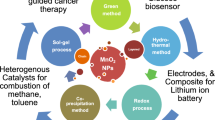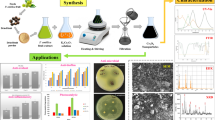Abstract
The antioxidant potential of superparamagnetic iron oxide nanoparticles functionalized with chitosan and graphene were examined in the present work. Coprecipitation technique was followed for the synthesis of iron oxide nanoparticles. Graphene-iron oxide nanocomposites were synthesized by mechanical mixing followed by the heat treatment at moderate temperature. The chitosan coated iron oxide nanoparticles were prepared by dispersing nanoparticles in chitosan solution. The nanoparticles/nanocomposites were characterized using XRD, SEM, TEM and HAADF-STEM for phase structure, morphology and elemental analysis. The superparamagnetic behavior of nanoparticles/nanocomposites were confirmed by magnetic measurements using vibrating sample magnetometry. Antioxidant efficacy of these nanoparticles/nanocomposites were investigated in terms of free radical scavenging and reducing potential using an array of in vitro assay system. Ferric reducing antioxidant power (FRAP) and 2,2′-diphenyl-1-picrylhydrazyl (DPPH) were used for the antioxidant capacity. The investigation suggests that the graphene improves the antiradical response of iron oxide nanoparticles at higher concentration which is almost comparable to the ascorbic acid used as standard.








Similar content being viewed by others
References
Chung YC, Chang CT, Chao WW, Lin CF, Chou ST. Antioxidative activity and safety of the 50% ethanolic extract from red bean fermented by Bacillus subtilis IMR-NK1. J Agric Food Chem. 2002;50:2454–8.
Duthie G. Lipid peroxidation. Eur J Clin Nutr. 1993;47:759–64.
Witschi HP. Enhanced tumour development by butylated hydroxytoluene (BHT) in the liver, lung and gastro-intestinal tract. Food Chem Toxicol. 1986;24:1127–30.
Grice HC. Safety evaluation of butylated hydroxyanisole from the perspective of effects on forestomach and oesophageal squamous epithelium. Food Chem Toxicol. 1988;26:717–23.
Moein MR, Moein S, Ahmadizadeh S. Radical scavenging and reducing power of salvia mirzayanii subfractions. Molecules. 2008;13:2804–13.
Kulisic T, Radonic A, Katalinic V, Milos M. Use of different methods for testing antioxidative activity of oregano essential oil. Food Chem. 2004;85:633–40.
Marques SS, Magalhães LM, Tóth IV, Segundo MA. Insights on antioxidant assays for biological samples based on the reduction of copper complexes-The importance of analytical conditions. Int J Mol Sci. 2014;15:11387–402.
Paul S, Saikia JP, Samdarshi SK, Konwar BK. Investigation of antioxidant property of iron oxide particlesby 1′-1′diphenylpicryl-hydrazyle (DPPH) method. J Magn Magn Mater. 2009;321:3621–3.
Frey NA, Peng S, Cheng K, Sun S. Magnetic nanoparticles: synthesis, functionalization, and applications in bioimaging and magnetic energy storage. Chem Soc Rev. 2009;27:2532–42.
Polshettiwar V, Luque R, Fihri A, Zhu H, Bouhrara M, Basset JM. Magnetically recoverable nanocatalysts. Chem Rev. 2011;111:3036–75.
Mangrulkar PA, Polshettiwar V, Labhsetwar NK, Varma RS, Rayalu SS. Nano-ferrites for water splitting: unprecedented high photocatalytic hydrogen production under visible light. Nanoscale. 2012;4:5202.
Kumar CSSR, Mohammad F. Magnetic nanomaterials for hyperthermia-based therapy and controlled drug delivery. Adv Drug Deliv Rev. 2011;63:789–808.
Pankhurst QA, Connolly J, K JS, Dobson J. Applications of magnetic nanoparticles in biomedicine. J Phys D Appl Phys. 2003;36:R167–81.
Qiao R, Yang C, Gao M. Superparamagnetic iron oxide nanoparticles: from preparations to in vivo MRI applications. J Mater Chem. 2009;19:6274.
Macher T, Totenhagen J, Sherwood J, Qin Y, Gurler D, Bolding MS, et al. Ultrathin iron oxide nanowhiskers as positive contrast agents for magnetic resonance imaging. Adv Funct Mater. 2015;25:490–4.
Iv M, Telischak N, Feng D, Holdsworth S, Yeom K, Daldrup-Link H. Clinical applications of iron oxide nanoparticles for magnetic resonance imaging of brain tumors. Nanomed (Lond). 2015;10:993–1018.
Goodwill PW, Conolly SM. Experimental demonstration of X-space magnetic particle imaging. SPIE Proc Med Imaging. 2011;7965:79650U–79650U–6.
Tomitaka A, Arami H, Gandhi S, Krishnan KM. Lactoferrin conjugated iron oxide nanoparticles for targeting brain glioma cells in magnetic particle imaging. Nanoscale R Soc Chem. 2015;7:16890–8.
Lu AH, Salabas EL, Schüth F. Magnetic nanoparticles: synthesis, protection, functionalization, and application. Angew Chem Int Ed Engl. 2007;46:1222–44.
Gupta AK, Gupta M. Synthesis and surface engineering of iron oxide nanoparticles for biomedical applications. Biomaterials. 2005;26:3995–4021.
Demirer GS, Okur AC, Kizilel S. Synthesis and design of biologically inspired biocompatible iron oxide nanoparticles for biomedical applications. J Mater Chem B. 2015;3:7831–49.
Kostevsek N, Locatelli E, Garrovo C, Arena F, Monaco I, Nikolov IP, et al. The one-step synthesis and surface functionalization of dumbbell-like gold–iron oxide nanoparticles: a chitosan-based nanotheranostic system. Chem Commun R Soc Chem. 2016;52:378–81.
Qiu Y, Wang Z, Owens ACE, Kulaots I, Yantao Chen AB. Antioxidant chemistry of graphene-based materials and its role in oxidation protection technology. Nanoscale . 2014;6:11744–55.
Stoller MD, Park S, Yanwu Z, An J, Ruoff RS. Graphene-based ultracapacitors. Nano Lett. 2008;8:3498–502.
Mayorov AS, Gorbachev RV, Morozov SV, Britnell L, Jalil R, Ponomarenko LA, Blake P, Novoselov KS, Watanabe K, Taniguchi T. Micrometer-scale ballistic transport in encapsulated graphene at room temperature. Nano Lett. 2011;11:2396–9.
Li X, Zhu Y, Cai W, Borysiak M, Han B, Chen D, et al. Transfer of large-area graphene films for high-performance transparent conductive electrodes. Nano Lett. 2009;9:4359–63.
Zhang Y, Tan YW, Stormer HL, Kim P. Experimental observation of the quantum Hall effect and Berry’s phase in graphene. Nature. 2005;438:201–4.
Moser J, Hertel S, Kisslinger F, Jobst J, Waldmann D, Krieger M, AB and ABB and AB. et al. Current-induced cleaning of graphene. Appl Phys Lett. 2011;98:3–6.
Yang Y, Asiri AM, Tang Z, Du D, Lin Y. Graphene based materials for biomedical applications. Mater Today Elsevier Ltd. 2013;16:365–73.
Bandi S, Hastak V, Peshwe DR, Srivastav AK.In-situ TiO2–rGO nanocomposites for CO gas sensing.Bull Mater Sci. 2018;41:115
Xuan Nui P, Tan Phuoc N, Tuyet Nhung P, Thi Thuy Nga TT, Hi V, Thi T. Synthesis and characterization of chitosan- coated magnetite nanoparticles and their application in curcumin drug delivery. Adv Nat Sci Nanosci Nanotechnol. 2016;7:1–9.
Benzie IFF, Strain JJ. The ferric reducing ability of plasma (FRAP) as a measure of “antioxidant power”: The FRAP assay. Anal Biochem. 1996;239:70–6.
Pulido R, Bravo L, Saura-Calixto F. Antioxidant activity of dietary polyphenols as determined by a modified ferric reducing/antioxidant power assay. J Agric Food Chem. 2000;48:3396–402.
Prieto P, Pineda M, Aguilar M. Spectrophotometric quantitation of antioxidant capacity through the formation of a phosphomolybdinum complex: specific application to the determination of Vitamin E. Anal Biochem. 1999;269:337–41.
Yen GC, Chen HY. Antioxidant activity of various tea extracts in relation to their antimutagenicity. J Agric Food Chem. 1995;43:27–32.
Luqman S, Kumar R, Kaushik S, Srivastava S, Darokar MP, Khanuja SPS. Antioxidant potential of the root of Vetiveria zizanioides (L.) Nash. Indian J Biochem Biophys. 2009;46:122–5.
Srivastav AK, Chawake N, Murty BS. Grain-size-dependent non-monotonic lattice parameter variation in nanocrystalline W: the role of non-equilibrium grain boundary structure. Scr Mater. 2015;98:20–3.
Cullity BD, Graham CD. Introduction to Magnetic Materials. B IEEE, ISBN 978-0-471-47741-9. 2008;47741.
Galano A.Carbon nanotubes as free-radical scavengers.J Phys Chem C. 2008;112:8922–7.
Bitner BR, Marcano DC, Berlin JM, Fabian RH, Cherian L, Culver JC, et al. Antioxidant carbon particles improve cerebrovascular dysfunction following traumatic brain injury. ACS Nano. 2012;6:8007–14.
Burton G, Ingold K. beta-Carotene: an unusual type of lipid antioxidant. Sci (80-). 1984;224:569–73.
Martínez A, Galano A. Free radical scavenging activity of ultrashort single-walled carbon nanotubes with different structures through electron transfer reactions. J Phys Chem C. 2010;114:8184–91.
Morita Y, Suzuki S, Sato K, Takui T. Synthetic organic spin chemistry for structurally well-defined open-shell graphene fragments. Nat Chem Nat Publ Group. 2011;3:197–204.
Wright JS, Johnson ER, DiLabio GA. Predicting the activity of phenolic antioxidants: theoretical method, analysis of substituent effects, and application to major families of antioxidants. J Am Chem Soc. 2001;123:1173–83.
Xie M, Hu B, Wang Y, Zeng X. Grafting of gallic acid onto chitosan enhances antioxidant activities and alters rheological properties of the copolymer. J Agric Food Chem. 2014;62:9128–36.
Spizzirri UG, Iemma F, Puoci F, Cirillo G, Curcio M, Parisi OI, et al. Synthesis of antioxidant polymers by grafting of gallic acid and catechin on gelatin. Biomacromolecules. 2009;10:1923–30.
Prodpran T, Benjakul S, Phatcharat S. Effect of phenolic compounds on protein cross-linking and properties of film from fish myofibrillar protein. Int J Biol Macromol Elsevier B V. 2012;51:774–82.
Aewsiri T, Benjakul S, Visessanguan W, Eun JB, Wierenga PA, Gruppen H. Antioxidative activity and emulsifying properties of cuttlefish skin gelatin modified by oxidised phenolic compounds. Food Chem Elsevier Ltd. 2009;117:160–8.
Acknowledgements
The authors are thankful to Mr. S.L. Gadge (Department of Metallurgical & Materials Engineering, VNIT Nagpur) for his constant support and motivation for the work.
Author information
Authors and Affiliations
Corresponding author
Ethics declarations
Conflict of interest
The authors declare that they have no conflict of interest.
Rights and permissions
About this article
Cite this article
Hastak, V., Bandi, S., Kashyap, S. et al. Antioxidant efficacy of chitosan/graphene functionalized superparamagnetic iron oxide nanoparticles. J Mater Sci: Mater Med 29, 154 (2018). https://doi.org/10.1007/s10856-018-6163-0
Received:
Accepted:
Published:
DOI: https://doi.org/10.1007/s10856-018-6163-0




